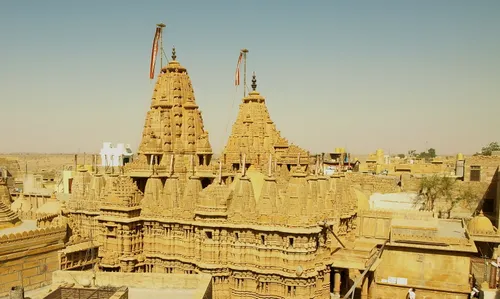
Jain Temples of Jaisalmer: A Journey into Rajasthan’s Spiritual and Architectural Heritage
Jaisalmer, often referred to as the “Golden City” of Rajasthan, is renowned for its stunning sand-colored architecture and its role as a key trade hub along the historic Silk Route. Among its many architectural marvels, the Jain temples of Jaisalmer stand out for their exquisite craftsmanship and spiritual significance. These temples are a testament to the prosperity of Jain merchants and their influence in the region during the medieval period.
Historical Context
Jaisalmer, founded in 1156 AD by Rawal Jaisal, became a prosperous city due to its strategic location along trade routes. The Jain community, known for its affluence and dedication to the arts, played a significant role in the city’s development. Many of the Jain temples in Jaisalmer were constructed between the 12th and 16th centuries, reflecting the grandeur and devotion of the era.
Key Jain Temples in Jaisalmer
Dilwara Temples:
- Historical Significance: The Dilwara Temples, not to be confused with the more famous Dilwara Temples in Mount Abu, are a group of five temples dedicated to various Jain Tirthankaras. They were built during the 12th to 15th centuries.
- Architectural Highlights: The temples are renowned for their stunning marble carvings and intricate architectural details. The use of white marble and the fine craftsmanship create an atmosphere of serene beauty. Notable temples within the group include:
- Lodurva Jain Temple: Known for its exquisite carvings and historical importance.
- Parshvanatha Temple: Dedicated to the 23rd Tirthankara, Parshvanatha, this temple features detailed carvings and serene interiors.
- Rishabdev Temple: Dedicated to Rishabdev, the first Tirthankara, it is noted for its elegant marble work and peaceful ambiance.
Kothari’s Jain Temple:
- Historical Significance: Located in the heart of Jaisalmer, this temple is dedicated to Tirthankara Adinatha and reflects the prosperity of the Kothari merchant family who funded its construction.
- Architectural Highlights: The temple features detailed carvings and a beautiful entrance. Its walls and ceilings are adorned with intricate patterns and religious motifs, showcasing the artistic flair of the period.
Jain Temple in Fort Complex:
- Historical Significance: Situated within the Jaisalmer Fort, this temple is dedicated to the Jain Tirthankaras and reflects the close relationship between Jainism and the fort’s history.
- Architectural Highlights: The temple is characterized by its ornate carvings and its integration with the fort’s architecture. It provides a glimpse into how Jain art and architecture blended with the military and residential structures of the fort.
Shantinatha Temple:
- Historical Significance: Dedicated to Tirthankara Shantinatha, this temple is an important pilgrimage site for Jains and reflects the dedication of the community to spiritual practices.
- Architectural Highlights: The temple is known for its elegant carvings and detailed artwork, with a serene and peaceful interior that encourages meditation and reflection.
Spiritual and Cultural Significance
The Jain temples of Jaisalmer are more than just architectural wonders; they are vital centers of Jain spirituality and culture. Jainism, which emphasizes non-violence, truth, and asceticism, has a deep-rooted presence in Jaisalmer, thanks to the contributions of wealthy Jain merchants and patrons. The temples serve as places of worship, meditation, and community gatherings, and they embody the values and artistic achievements of the Jain community.
Practical Information for Visitors
Timing: Most Jain temples in Jaisalmer are open during the day. However, it’s advisable to check specific opening hours or visit schedules before planning your trip.
Dress Code: Modest attire is required when visiting the temples. Visitors should dress conservatively, covering shoulders and knees. Removing shoes before entering the temples is also mandatory.
Photography: Photography may be restricted inside the temples to preserve their sanctity and delicate artwork. It’s best to ask for permission or check the rules upon arrival.
Respect: Maintaining silence and showing respect for the religious practices observed in the temples is important. This helps preserve the tranquil and spiritual environment of these sacred spaces.
Getting There
Jaisalmer is accessible by road, rail, and air. The nearest major city is Jodhpur, approximately 300 kilometers away. From Jodhpur, you can travel to Jaisalmer by train, bus, or car. Jaisalmer also has an airport with connections to major cities in India.
The Jain temples are located within the city and the fort complex, making them relatively easy to visit. Local guides can provide valuable insights and help navigate the historical and architectural details of the temples.
The Jain temples of Jaisalmer offer a fascinating glimpse into the spiritual and artistic heritage of the region. Their intricate carvings, serene ambiance, and historical context make them a must-visit for anyone interested in Jainism, architecture, or the rich cultural tapestry of Rajasthan. A visit to these temples not only reveals the grandeur of past civilizations but also provides a tranquil space for reflection and admiration.
